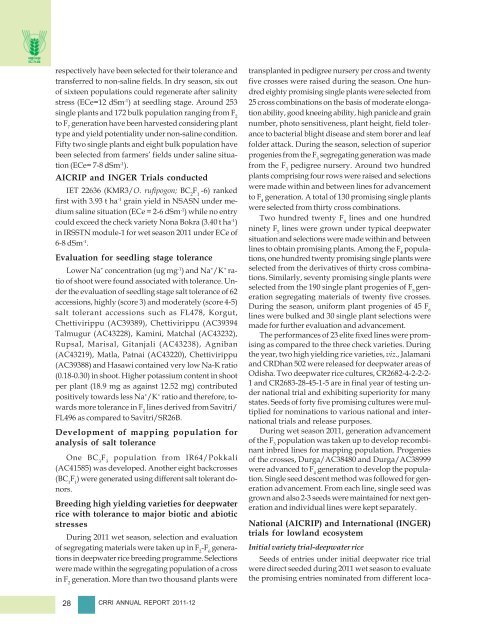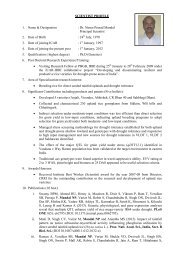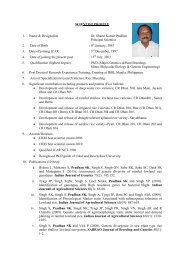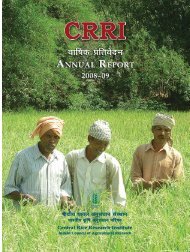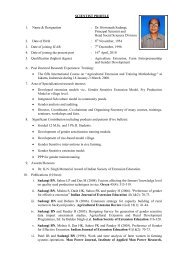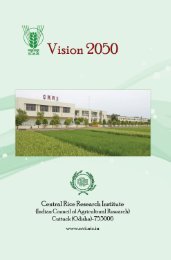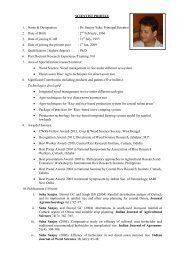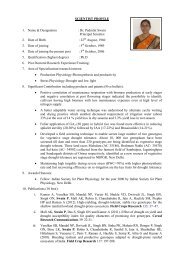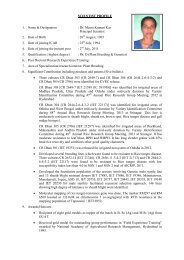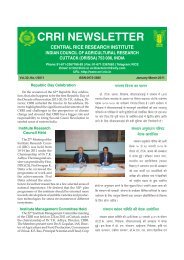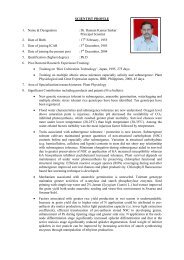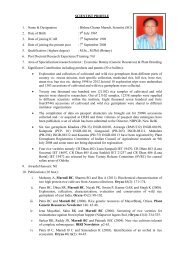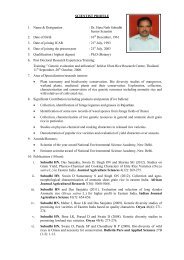Central Rice Research Institute Annual report...2011-12
Central Rice Research Institute Annual report...2011-12
Central Rice Research Institute Annual report...2011-12
Create successful ePaper yourself
Turn your PDF publications into a flip-book with our unique Google optimized e-Paper software.
espectively have been selected for their tolerance and<br />
transferred to non-saline fields. In dry season, six out<br />
of sixteen populations could regenerate after salinity<br />
stress (ECe=<strong>12</strong> dSm -1 ) at seedling stage. Around 253<br />
single plants and 172 bulk population ranging from F 2<br />
to F 7<br />
generation have been harvested considering plant<br />
type and yield potentiality under non-saline condition.<br />
Fifty two single plants and eight bulk population have<br />
been selected from farmers’ fields under saline situation<br />
(ECe= 7-8 dSm -1 ).<br />
AICRIP and INGER Trials conducted<br />
IET 22636 (KMR3/O. rufipogon; BC 2<br />
F 1<br />
-6) ranked<br />
first with 3.93 t ha -1 grain yield in NSASN under medium<br />
saline situation (ECe = 2-6 dSm -1 ) while no entry<br />
could exceed the check variety Nona Bokra (3.40 t ha -1 )<br />
in IRSSTN module-1 for wet season 2011 under ECe of<br />
6-8 dSm -1 .<br />
Evaluation for seedling stage tolerance<br />
Lower Na + concentration (ug mg -1 ) and Na + /K + ratio<br />
of shoot were found associated with tolerance. Under<br />
the evaluation of seedling stage salt tolerance of 62<br />
accessions, highly (score 3) and moderately (score 4-5)<br />
salt tolerant accessions such as FL478, Korgut,<br />
Chettivirippu (AC39389), Chettivirippu (AC39394<br />
Talmugur (AC43228), Kamini, Matchal (AC43232),<br />
Rupsal, Marisal, Gitanjali (AC43238), Agniban<br />
(AC43219), Matla, Patnai (AC43220), Chettivirippu<br />
(AC39388) and Hasawi contained very low Na-K ratio<br />
(0.18-0.30) in shoot. Higher potassium content in shoot<br />
per plant (18.9 mg as against <strong>12</strong>.52 mg) contributed<br />
positively towards less Na + /K + ratio and therefore, towards<br />
more tolerance in F 2<br />
lines derived from Savitri/<br />
FL496 as compared to Savitri/SR26B.<br />
Development of mapping population for<br />
analysis of salt tolerance<br />
One BC 3<br />
F 3<br />
population from IR64/Pokkali<br />
(AC41585) was developed. Another eight backcrosses<br />
(BC 1<br />
F 1<br />
) were generated using different salt tolerant donors.<br />
Breeding high yielding varieties for deepwater<br />
rice with tolerance to major biotic and abiotic<br />
stresses<br />
During 2011 wet season, selection and evaluation<br />
of segregating materials were taken up in F 2<br />
-F 6<br />
generations<br />
in deepwater rice breeding programme. Selections<br />
were made within the segregating population of a cross<br />
in F 2<br />
generation. More than two thousand plants were<br />
transplanted in pedigree nursery per cross and twenty<br />
five crosses were raised during the season. One hundred<br />
eighty promising single plants were selected from<br />
25 cross combinations on the basis of moderate elongation<br />
ability, good kneeing ability, high panicle and grain<br />
number, photo sensitiveness, plant height, field tolerance<br />
to bacterial blight disease and stem borer and leaf<br />
folder attack. During the season, selection of superior<br />
progenies from the F 3<br />
segregating generation was made<br />
from the F 3<br />
pedigree nursery. Around two hundred<br />
plants comprising four rows were raised and selections<br />
were made within and between lines for advancement<br />
to F 4<br />
generation. A total of 130 promising single plants<br />
were selected from thirty cross combinations.<br />
Two hundred twenty F 4<br />
lines and one hundred<br />
ninety F 5<br />
lines were grown under typical deepwater<br />
situation and selections were made within and between<br />
lines to obtain promising plants. Among the F 4<br />
populations,<br />
one hundred twenty promising single plants were<br />
selected from the derivatives of thirty cross combinations.<br />
Similarly, seventy promising single plants were<br />
selected from the 190 single plant progenies of F 5<br />
generation<br />
segregating materials of twenty five crosses.<br />
During the season, uniform plant progenies of 45 F 6<br />
lines were bulked and 30 single plant selections were<br />
made for further evaluation and advancement.<br />
The performances of 23 elite fixed lines were promising<br />
as compared to the three check varieties. During<br />
the year, two high yielding rice varieties, viz., Jalamani<br />
and CRDhan 502 were released for deepwater areas of<br />
Odisha. Two deepwater rice cultures, CR2682-4-2-2-2-<br />
1 and CR2683-28-45-1-5 are in final year of testing under<br />
national trial and exhibiting superiority for many<br />
states. Seeds of forty five promising cultures were multiplied<br />
for nominations to various national and international<br />
trials and release purposes.<br />
During wet season 2011, generation advancement<br />
of the F 3<br />
population was taken up to develop recombinant<br />
inbred lines for mapping population. Progenies<br />
of the crosses, Durga/AC38480 and Durga/AC38999<br />
were advanced to F 4<br />
generation to develop the population.<br />
Single seed descent method was followed for generation<br />
advancement. From each line, single seed was<br />
grown and also 2-3 seeds were maintained for next generation<br />
and individual lines were kept separately.<br />
National (AICRIP) and International (INGER)<br />
trials for lowland ecosystem<br />
Initial variety trial-deepwater rice<br />
Seeds of entries under initial deepwater rice trial<br />
were direct seeded during 2011 wet season to evaluate<br />
the promising entries nominated from different loca-<br />
28 CRRI ANNUAL REPORT 2011-<strong>12</strong>


